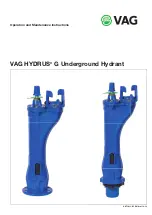
VAG Operation and Maintenance Instructions • 4
-20 °C to + 50 °C (protected by adequate covers). If the valve is
stored at temperatures below 0 °C, it should be warmed up to at
least +5° C before installation and before it is put into operation.
3 Product features
3.1 Features and function description
In its dimensions, function and hygienic characteristics the VAG
HYDRUS
®
G Underground Hydrant meets current standards.
• VP 325 Hydrants, requirements and tests
• EN 1074-6 Hydrants, requirements, fitness for purpose and ve-
rification tests
3.2 Applications
Due to the EPDM gasket materials used the standard version of
the VAG HYDRUS
®
G Underground Hydrant is suitable for the
following media:
• Water, at a maximum temperature of 50°C
The use of media containing oil and gas may damage the lining
and gaskets and is thus not permissible.
For information about the corresponding temperature limits, ple-
ase refer to the product-related technical documentation (KAT
1611-A).
In case of deviating operating conditions and applications, please
consult the manufacturer.
3.3 Permissible and impermissible modes of
operation
The maximum operating temperatures and operating pressures
specified in the technical documentation (KAT 1611-A) must not
be exceeded.
The pressure applied to the closed valve must not exceed its ra-
ted pressure.
For reasons of cavitation safety the maximum flow rate should not
exceed 1.5 times the Kv-value according to applicable technical
standards.
The valve may only be operated in fully opened position. Regu-
lation of the flow may only take place via the extraction valves
located on the standpipe.
Extracting water while the shut-off cone is in a partially open po-
sition can cause cavitation effect in the seat area, resulting in lea-
kiness.
For correct operation of the valve DVGS standard W 331 must be
complied with.
The metallic limit stops when the hydrant is in open and closed
position are clearly noticeable. The design of the installed sealing
system guarantees tightness in this position. It is thus not neces-
sary to exert extra force to close the valve into an end position.
This may cause an overload of the limit stops, or result in the valve
being stuck in an end position or damaged.
4 Installation into the pipeline
4.1 Conditions required on site
Observe the provisions of the DVGW standard W 331
when installing the VAG HYDRUS
®
G Underground
Hydrant.
The flange version of the VAG HYDRUS
®
G is deli-
vered with a multifunction seal integrated in the flange. An additi-
onal flat seal for the flange connection to the pipeline should not
be used. The multifunction seal should not be removed, because
doing so will impair the function of the hydrant during operation.
To reliably drain the underground hydrant we recommend the ad-
ditional installation of the VAG seepage stone.
Without a seepage stone the lower draining point must be sur-
rounded by packed gravel or crushed rock that permits draining.
The draining area (immediately above the flange connection) must
never be blocked by the external application of sealants
4.2 Assembly instructions and fitting
Check the valve for possible damage that it may have occurred
during transport and storage. Until installation the valve is protec-
ted from dirt accumulating during construction site operations via
a factory mounted cover (13 or 21).
4.3 Assembly of the VAG HYDRUS
®
G
Underground Hydrant
Remove the protective flange cover (13) prior to attachment to the
pipeline, for a version with BAIO
®
spigot end detach the transport
guard (21) from the spigot end.
Picture 2: : Detailed view of assembly instructions
13
6
19
20
21
4.3.1 HYDRUS
®
G flange version
Multifunction sealing ring (6) is pressed in at the factory and is
used as a sealing for the pipeline flange. An additional flat seal
should not be used.
After attaching the underground hydrant tighten the flange bolting
crosswise.
4.3.2 HYDRUS
®
G BAIO Spigot end version
Push the spigot end into the socket all the way to the stop and
turn the hydrant 45° clockwise all the way to the noticeable metal-




























